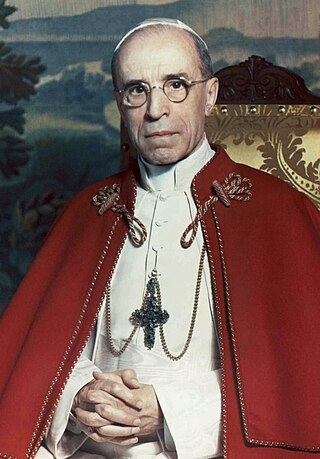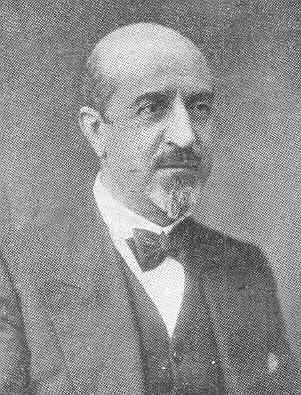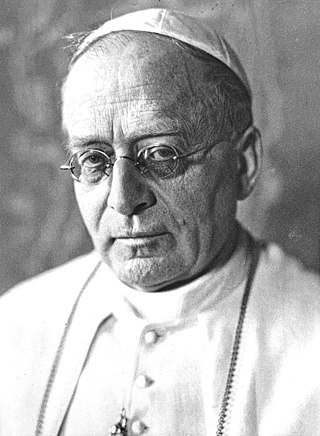Related Research Articles

Pope Pius XII was head of the Catholic Church and sovereign of the Vatican City State from 2 March 1939 until his death in October 1958. Before his election to the papacy, he served as secretary of the Department of Extraordinary Ecclesiastical Affairs, papal nuncio to Germany, and Cardinal Secretary of State, in which capacity he worked to conclude treaties with various European and Latin American nations, including the Reichskonkordat treaty with the German Reich.

The Lateran Treaty was one component of the Lateran Pacts of 1929, agreements between the Kingdom of Italy under King Victor Emmanuel III and the Holy See under Pope Pius XI to settle the long-standing Roman Question. The treaty and associated pacts were named after the Lateran Palace where they were signed on 11 February 1929, and the Italian parliament ratified them on 7 June 1929. The treaty recognised Vatican City as an independent state under the sovereignty of the Holy See. The Italian government also agreed to give the Roman Catholic Church financial compensation for the loss of the Papal States. In 1948, the Lateran Treaty was recognized in the Constitution of Italy as regulating the relations between the state and the Catholic Church. The treaty was significantly revised in 1984, ending the status of Catholicism as the sole state religion.

Pope Pius XI, born Ambrogio Damiano Achille Ratti, was the Bishop of Rome and supreme pontiff of the Catholic Church from 6 February 1922 to 10 February 1939. He also became the first sovereign of the Vatican City State upon its creation as an independent state on 11 February 1929. He remained head of the Catholic Church until his death in February 1939. His papal motto was "Pax Christi in Regno Christi", translated as "The Peace of Christ in the Reign of Christ".

The Concordat of 1801 was an agreement between Napoleon Bonaparte and Pope Pius VII, signed on 15 July 1801 in Paris. It remained in effect until 1905, except in Alsace–Lorraine, where it remains in force. It sought national reconciliation between revolutionaries and Catholics and solidified the Roman Catholic Church as the majority church of France, with most of its civil status restored. This resolved the hostility of devout French Catholics against the revolutionary state. It did not restore the vast Church lands and endowments that had been seized during the Revolution and sold off. Catholic clergy returned from exile, or from hiding, and resumed their traditional positions in their traditional churches. Very few parishes continued to employ the priests who had accepted the Civil Constitution of the Clergy of the revolutionary regime. While the Concordat restored much power to the papacy, the balance of church-state relations tilted firmly in Napoleon's favour. He selected the bishops and supervised church finances.
A concordat is a convention between the Holy See and a sovereign state that defines the relationship between the Catholic Church and the state in matters that concern both, i.e. the recognition and privileges of the Catholic Church in a particular country and with secular matters that affect church interests.

The Reichskonkordat is a treaty negotiated between the Vatican and the emergent Nazi Germany. It was signed on 20 July 1933 by Cardinal Secretary of State Eugenio Pacelli, who later became Pope Pius XII, on behalf of Pope Pius XI and Vice Chancellor Franz von Papen on behalf of President Paul von Hindenburg and the German government. It was ratified 10 September 1933 and it has been in force from that date onward. The treaty guarantees the rights of the Catholic Church in Germany. When bishops take office Article 16 states they are required to take an oath of loyalty to the Governor or President of the German Reich established according to the constitution. The treaty also requires all clergy to abstain from working in and for political parties. Nazi breaches of the agreement began almost as soon as it had been signed and intensified afterwards leading to protest from the Church including in the 1937 Mit brennender Sorge encyclical of Pope Pius XI. The Nazis planned to eliminate the Church's influence by restricting its organizations to purely religious activities.

Mit brennender Sorge is an encyclical of Pope Pius XI, issued during the Nazi era on 10 March 1937. Written in German, not the usual Latin, it was smuggled into Germany for fear of censorship and was read from the pulpits of all German Catholic churches on one of the Church's busiest Sundays, Palm Sunday.

Pietro Gasparri was a Roman Catholic cardinal, diplomat and politician in the Roman Curia and the signatory of the Lateran Pacts. He served also as Cardinal Secretary of State under Popes Benedict XV and Pope Pius XI.

Michael Ritter von Faulhaber was a German Catholic prelate who served as Archbishop of Munich for 35 years, from 1917 to his death in 1952. Created Cardinal in 1921, von Faulhaber remained an outspoken monarchist and denounced the Weimar Republic as rooted in "perjury and treason" against the German Empire during a speech at the 62nd German Catholics' Day of 1922. Cardinal von Faulhaber was a senior member and co-founder of the Amici Israel, a priestly association founded in Rome in 1926 with the goal of working toward the Jewish people's conversion to Roman Catholicism, while also seeking to combat antisemitism within the Church.

Ludwig Kaas was a German Roman Catholic priest and politician of the Centre Party during the Weimar Republic. He was instrumental in brokering the Reichskonkordat between the Holy See and the German Reich.

Hitler's Pope is a book published in 1999 by the British journalist and author John Cornwell that examines the actions of Eugenio Pacelli, who became Pope Pius XII, before and during the Nazi era, and explores the charge that he assisted in the legitimization of Adolf Hitler's Nazi regime in Germany, through the pursuit of a Reichskonkordat in 1933. The book is critical of Pius' conduct during the Second World War, arguing that he did not do enough, or speak out enough, against the Holocaust. Cornwell argues that Pius's entire career as the nuncio to Germany, Cardinal Secretary of State, and Pope, was characterized by a desire to increase and centralize the power of the Papacy, and that he subordinated opposition to the Nazis to that goal. He further argues that Pius was antisemitic and that this stance prevented him from caring about the European Jews.

Robert Leiber, S.J. was a close advisor to Pope Pius XII, a Jesuit priest from Germany, and Professor for Church History at the Gregorian University in Rome from 1930 to 1960. Leiber was, according to Pius's biographer Susan Zuccotti, "throughout his entire papacy his private secretary and closest advisor".
Kirchenkampf is a German term which pertains to the situation of the Christian churches in Germany during the Nazi period (1933–1945). Sometimes used ambiguously, the term may refer to one or more of the following different "church struggles":
- The internal dispute within German Protestantism between the German Christians and the Confessing Church over control of the Protestant churches;
- The tensions between the Nazi regime and the Protestant church bodies; and
- The tensions between the Nazi regime and the Roman Catholic Church.
The 1925 concordat (agreement) between the Holy See and the Second Polish Republic had 27 articles, which guaranteed the freedom of the Church and the faithful. It regulated the usual points of interests, Catholic instruction in primary schools and secondary schools, nomination of bishops, establishment of seminaries, a permanent nuncio in Warsaw, who also represents the interests of the Holy See in Gdańsk. It was considered one of the most favorable concordats for the Holy See, and would become a basis for many future concordats.

Francesco Pacelli was an Italian lawyer and the elder brother of Eugenio Pacelli, who would later become Pope Pius XII. He acted as a legal advisor to Pope Pius XI; in this capacity, he assisted Cardinal Secretary of State Pietro Gasparri in the negotiation of the Lateran Treaty, which established the independence of Vatican City.
The Concordat of 1851 was a concordat between the Spanish government of Queen Isabella II and the Vatican. It was negotiated in response to the policies of the anticlerical Liberal government, which had forced her mother out as regent in 1841. Although the concordat was signed on 16 March 1851, its terms were not implemented until 1855.

Popes Pius XI (1922–1939) and Pius XII (1939–1958) led the Catholic Church during the rise and fall of Nazi Germany. Around a third of Germans were Catholic in the 1930s, most of them lived in Southern Germany; Protestants dominated the north. The Catholic Church in Germany opposed the Nazi Party, and in the 1933 elections, the proportion of Catholics who voted for the Nazi Party was lower than the national average. Nevertheless, the Catholic-aligned Centre Party voted for the Enabling Act of 1933, which gave Adolf Hitler additional domestic powers to suppress political opponents as Chancellor of Germany. President Paul Von Hindenburg continued to serve as Commander and Chief and he also continued to be responsible for the negotiation of international treaties until his death on 2 August 1934.

During the pontificate of Pope Pius XI (1922–1939), the Weimar Republic transitioned into Nazi Germany. In 1933, the ailing President von Hindenburg appointed Adolf Hitler as Chancellor of Germany in a Coalition Cabinet, and the Holy See concluded the Reich concordat treaty with the still nominally functioning Weimar state later that year. Hoping to secure the rights of the Church in Germany, the Church agreed to a requirement that clergy cease to participate in politics. The Hitler regime routinely violated the treaty, and launched a persecution of the Catholic Church in Germany.

Formal diplomatic relations between the Holy See and the current Federal Republic of Germany date to the 1951 and the end of the Allied occupation. Historically the Vatican has carried out foreign relations through nuncios, beginning with the Apostolic Nuncio to Cologne and the Apostolic Nuncio to Austria. Following the dissolution of the Holy Roman Empire and the Congress of Vienna, an Apostolic Nuncio to Bavaria replaced that of Cologne and that mission remained in Munich through several governments. From 1920 the Bavarian mission existed alongside the Apostolic Nuncio to Germany in Berlin, with which it was merged in 1934.
The Apostolic Nunciature to Bavaria was an ecclesiastical office of the Roman Catholic Church in Bavaria. It was a diplomatic post of the Holy See, whose representative was called the Apostolic Nuncio to Bavaria, a state – consecutively during the nunciature's existence – of the Holy Roman Empire, of its own sovereignty, and then of Imperial, Weimar and finally Nazi Germany. The office of the nunciature was located in Munich from 1785 to 1936. Prior to this, there was one nunciature in the Holy Roman Empire, which was the nunciature in Cologne, accredited to the Archbishop-Electorates of Cologne, Mainz and Trier.
References
- ↑ , Contract between the Republic of Austria and the Holy See (July 9, 1962)
- ↑ "Konkordat" aeiou, Technische Universität Graz (in German)
- ↑ Österreichisches Konkordat, Wilhelm Rees (in German)
- ↑ "Journal of Religion and Society". Archived from the original on 2010-08-03. Retrieved 2010-06-22., Catholicism and Democracy: A Reconsideration Edward Bell Brescia University College at the University of Western Ontario Journal of Religion and Society, volume 10, 2008.
- ↑ Concordat text with Secret Supplement (in English)